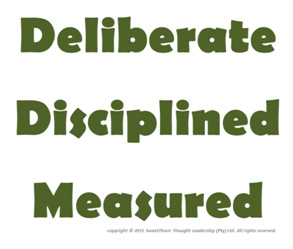With daily technological advances in the SAP world, there is a tendency to focus more on the next best piece of technology, and to forget that you already own a powerful set of basic tools, which you may never have known about, or if you did, have lost through staff attrition over the years.
There are 3 key focus areas that you will need to address in getting back to basics. You’ll probably know what they are, but I hope to challenge your thinking on what needs to be done to re-establish basics in your SAP driven supply chain.
Train
This is a good starting point. From an SAP point of view this is often the “click-here-click-there-save” stuff. It is very necessary, but you rely heavily on the Trainee to go back into the work place and apply their new knowledge - mostly they do not.
Another challenge is to figure out what training you need, and this is very hard to do if you do not know, what you do not know, in other words you are unconsciously incompetent. It is advisable to seek guidance on what it is you need to know, which in itself can be another challenge. Once you have figured out what you need to know, we then strongly advise that you link your training to a very tangible business objective – something that you can very easily measure. Yet, another challenge.
Educate

Education is the next level of training. This is about building capacity in your supply chain that empowers your operators to analyse their outcomes and decide on appropriate action
when these outcomes are not being met (customer service improvement, for example - a good measure to link your training and education efforts to). By implication then; buyers, planners, MRP and Inventory controllers need to be equipped to make decisions
and then to update the relevant SAP rulesets (mostly dynamic master data) to capture these decisions.
This moves the operators in your business from being virtual paper-pushers to individuals who add tremendous value to your business, using SAP to understand and fix the cause and effect. This is not a quick process and requires high levels of confidence, for both operators and their managers.
Your internal customers will also need to trust your decision making, which most likely will require some serious change management.
And there you have several more not-so-basic challenges!
Change Manage
Research shows that between 40 and 70% of change management efforts fail. This is because change needs to move from banners, balloons and a game of paintball style interventions, to ones that are deliberate, disciplined, and measured. If you have been live on SAP for more than 6-12 months, you have the mechanisms at your disposal to make this kind of change – the kind that sticks.
Change has to move away from been a warm, fuzzy theoretical journey to one that is driven by cold, hard facts. Your SAP system has data (extracted through standard reports) that can be used to measure individual contribution to your supply chain’s effectiveness – if you like, their good behaviour, their bad behaviour and how other’s behaviour in the supply chain affects everyone's daily output. This data is used to drive tangible and sustainable change.
Business Maturity Optimisation
Throw this kind of training, education and change management into one pot, and you have what we call Business Maturity Optimisation (BMO). The fundamental technique of BMO is to use standard SAP tools and reports to extract information from your live SAP system to identify, drive and measure supply chain optimisation programmes. BMO has clearly defined, non-negotiable steps (deliberate), entrenches strict routine and leading practice habits (disciplined) and reports weekly on delivery against SAP’s supply chain KPIs (measured).
As you tackle your back to basics initiatives, remember the departure point: Figure out what it is that you do not know and understand what tangible benefit you will get from knowing what you will get to know – and for this you will most likely require some assistance.
